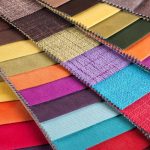In this blog post; we will focus on What is Kenaf Fiber? Why Kenaf is used for Kenaf Fibre Fabrics. Kenaf is a bast fiber.
You May Read: Top 10 Bast Fiber
What is Kenaf Fiber?
Kenaf is a plant in the family Malvaceae also called Deccan hemp and Java jute. The fibers in kenaf are found in the bast (bark) and core (wood). The bast constitutes 40% of the plant. “Crude fiber” separated from the bast is multi-cellular; consisting of several individual cells stuck together. The individual fiber cells are about 2–6 mm long and slender.
Kenaf Fiber Properties
Tensile tests of kenaf fiber with different characteristics were carried out and their potential application to the reinforcement of FRP was conducted.
Specifically, the effect of stem diameter and length on the mechanical properties of kenaf fiber of different types was investigated.
In addition, after converting kenaf fibers into pulp, the cellulose content ratios and extent of polymerization within the fibers were measured to investigate their influence on the tensile strength of the fibers.
The tensile strength of kenaf fiber was observed to increase with the length of the stem. Moreover, at approximately 48%, the ratio of cellulose contained in kenaf fiber was found to be stable regardless of the length and diameter of the kenaf stem.
Cellulose DP in kenaf fibers was observed to change depending on the tensile strength of the fiber and longer kenaf fibers were found to have relatively higher tensile strengths and cellulose DP.
Uses of Kenaf Fiber
Kenaf fiber (Hibiscus cannabinus L.) is a type of natural fiber offering many advantages and high potential as reinforcement in composite materials, especially polymer composites.
Conventionally, synthetic fibers such as carbon, glass, and aramid are commonly used in the production of polymer composites, but kenaf fibers have comparable specific properties and relatively low processing costs favoring their substitution for conventional synthetic fibers.
Read Textile Fiber | Types, Properties and Classification
Kenaf fibers may be modified either physically or chemically and used for either thermoset or thermoplastic polymer systems. Fields of use for kenaf fiber-reinforced composites include construction, automotive, corrosion resistance, electrical, marine, and transportation.
Environmental Benefits:
Kenaf has an ability to absorb huge quantities of CO2, the global warming gas, comparatively 3 times more than a tree. It can convert more CO2 than a tropical rain forest during its growth. Further, it can also improve the soil structure while fixing soil nutrients. It is biodegradable, as no chemicals or pesticides are used during its cultivation.
Kenaf fibers are a good alternative to synthetic fibers. They offer sustainable advantages while also enhancing cost-saving amidst increasing fuel prices. Keep kenaf fiber fabrics on the wardrobe and be the coolest kid on the block.
Textile industry applications:
Fibers spun from kenaf are extremely long, making it a good choice for weaving fabrics. The plant’s stalk contains less than 30% lignin, making its fiber extraction easier when compared with other natural fibers. Lignin is a glue-like substance that fills spaces in the plant fibres. Kenaf fibres find useful applications in making knit and woven textiles. These fibres blend very well with cotton and finds commercial and healthy applications in making outerwear owing to its natural absorbency, and fire-retardant abilities.





